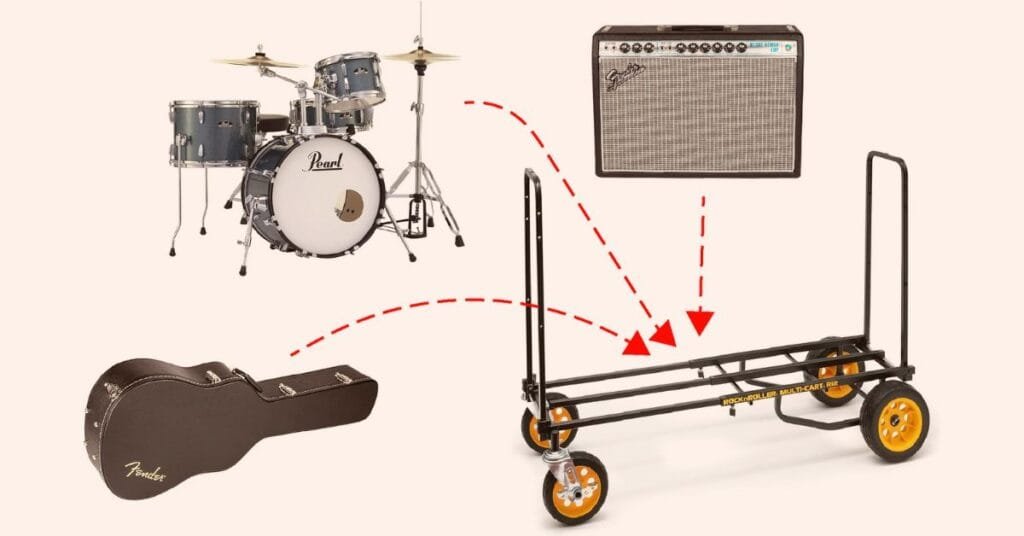Mastering line Array types in portable column PA systems: The J and C shape explained
Introduction
Remember when PA speakers started getting smaller in the 1990s? Those mid-high frequency boxes stacked in a curvy line way up high on a big stage looked pretty cool. And they still do. Nowadays, they’re even smaller, but stronger. Then came 2003, when Bose launched the L1 system, the world’s first small line array PA system. This was the beginning of a new era for small bands, making it possible to play gigs with portable column PA systems that had unbelievable sound dispersion.
We all see column public address speaker systems with line-array type enclosures all around us. They are becoming a standard for events where sound dispersion and looks matter. Let’s not get confused, we are not focusing on touring line arrays in this blog post, but rather the small, portable column PAs. But what do we know about how the small speakers in these columns are geometrically placed? The most common curved shapes are C-shaped and J-shaped column PAs.
In this article, we will explore:
- What C-shaped and J-shaped array PA systems are
- How they differ from straight arrays
- What are the line array configurations in the most popular column PAs
- Which shape is right for the type of venues and gigs you play
Understanding array shapes will help you play any type of gig: weddings, small clubs, local cafe, or outdoor beer festival.
What is a line array speaker?
A line array is a set of small loudspeakers that are vertically stacked. This design ensures sound waves project cohesively, rather than as numerous separate waves. Because of this vertical alignment, the vertical dispersion in these systems is narrower than in point source or standard PA speakers. Because of the narrow vertical projection, sound volume starts dropping further than with standard speakers. The column PA also enables a much wider horizontal sound dispersion than in traditional speakers, making it an ideal solution for even sound coverage.
In large touring rigs, speakers are hung in an arc-shaped stack. A similar principle is used in compact column PAs: small drivers stacked in a vertical column, but not always in a straight line.
The C-shaped array PA system
Why is it called a C-shaped array? When viewed sideways, the top speakers aim straight to the back of the venue. But as you look down, the lower speakers are slightly tilted more and more as they get lower, providing quality sound for the first rows all the way to the back of the venue. The curve that this line array configuration resembles the letter “C” because of its continuous curve.
The continuous shape tells us that the goal for this type of small line array is to project sound evenly at all distances. Whether you are in the front, middle, or back of the venue, you will hear an even sound quality. The sound’s volume is obviously going to slowly drop, but still not as fast as with point-source speakers.
C-shaped column PAs are perfect for small to mid-sized venues. Examples of portable column PAs with a C-shaped line array geometrical configuration are:
- Bose L1 Pro8 – View on Amazon
- JBL IRX ONE – View on Amazon
- JBL EON One MK2 – View on Amazon
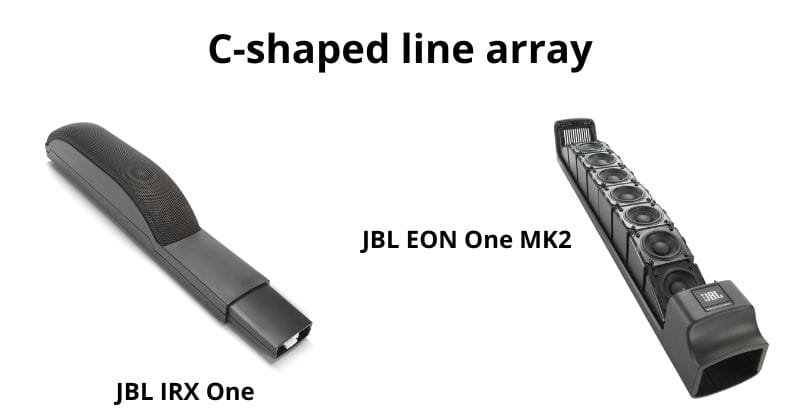
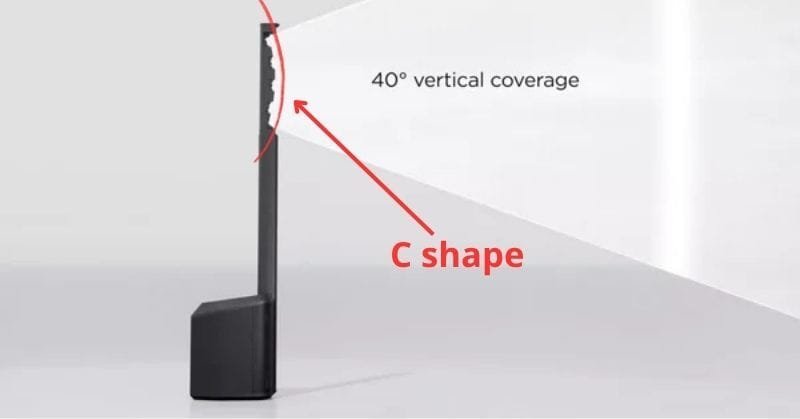
The J-shaped array PA system
The J-shaped type of line arrays in column PA speakers follows the same principle as in the C-shape type; it resembles the letter “J”. As the shape of the letter “J” suggests, the upper portion of the column follows a straight vertical line, while only the lower section is curved for near-field coverage. Why would we use this type of line array?
Some venues are very long, making it harder to cover with a column PA. With multiple small speakers stacked in a straight line, the back of the room gets more sound power delivered than with a C-shaped column PA. Doesn’t that mean that some nearer middle sections do not get good coverage? Perhaps theoretically, but on many occasions, most listeners are not very close to the PA. This is where the J-shaped line array column system works best: a larger venue, with focus on depth. A higher venue can also benefit from a J-shaped line array for the same reasons.
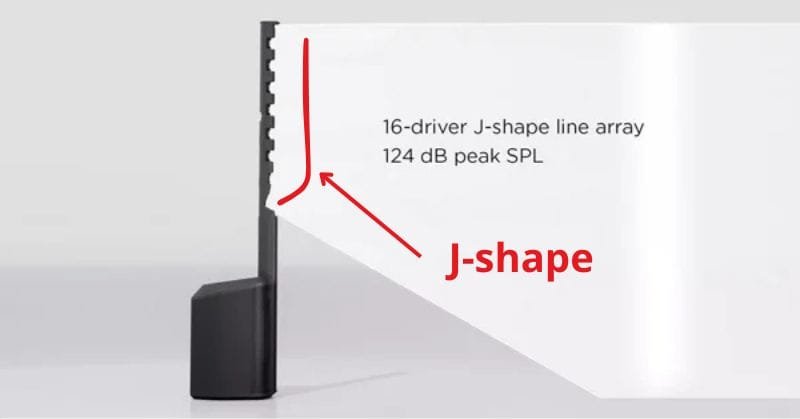
Not many manufacturers specify their products with a J-shaped column. The most popular one that mentions it in its specifications is the Bose L1 Pro16, which is the larger brother of the Bose L1 Pro8.
This makes sense because larger and longer rooms need better projection (J-shape) and, of course, more power.
Other curved line array types in column PAs
- The RCF EVOX J8 is not classified as a J-shape, but according to the manufacturer, it resembles one. “The vertical array is progressively shaped to guarantee consistent sound coverage from the first row to the last.” (RCF)
- This is how RCF describes their RCF EVOX 12’s column: “…slightly tilted pattern control…” (RCF)
- HK Audio says this about their Polar 8: “6 x 2.5″ Midrange speakers in curved column arrangement.”
- LD Systems Curv 500 TS has 4 line array speakers that form a J-shape, but is not listed as one.
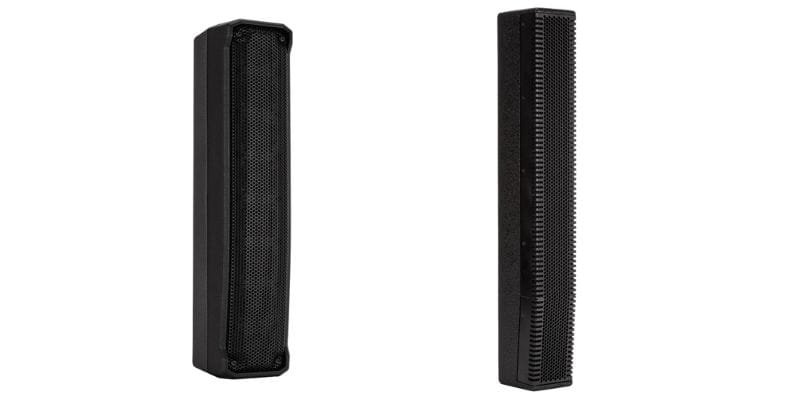
Straight line array configurations
Some other models may have slightly curved columns that are classified as logarithmic or have the part with speakers tilted for a better projection, like the QSC KC12. All other models can be classified as “straight line array configurations”, where all the drivers follow a straight vertical line.
Some straight line line array column PA systems:
- JBL PRX One – View on Amazon
- HK Audio Polar 12 MK2 – View on Amazon
- Bose L1 Pro32 – View on Amazon
- LD Systems Maui 28 G3 – View on Amazon
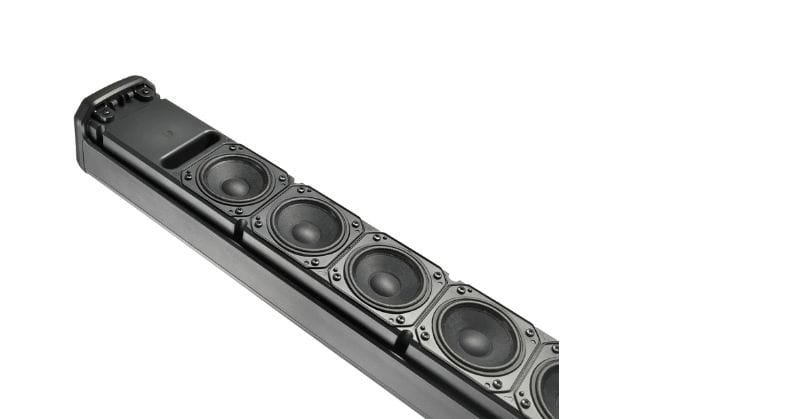
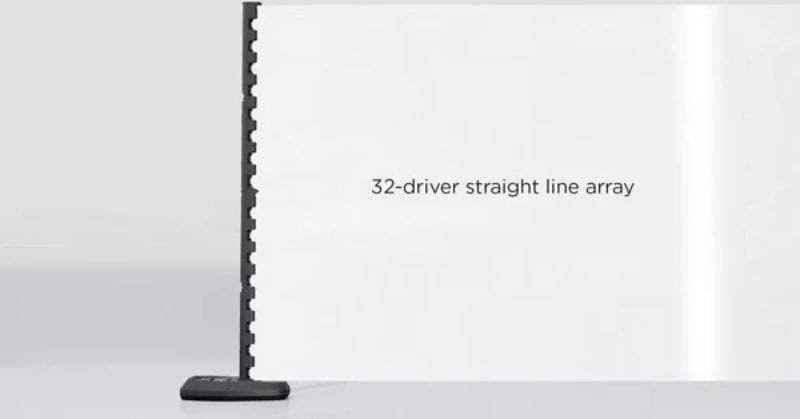
Curved vs straight line array
Straight line array speaker systems are best for long venues and outdoor stages, whereas curved line arrays work better in small to mid-sized indoor venues and small outdoor gigs.
Array geometry in portable column PA systems
Portable column PAs stack speakers in a small vertical line-array in geometrical shapes similar to those in big concert rigs. Column systems like Bose L1, JBL EON One, and QSC KC12 give us the benefits of the big rigs, just scaled for smaller venues.
Benefits include:
- Focused vertical dispersion, catered to specific needs
- Reduced reflections
- Even sound quality and level throughout the whole room
- Extremely easy transport and setup: nothing compared to touring rigs
Comparison table of configurations
| Shape | Example systems | Description | Coverage | Best for |
|---|---|---|---|---|
| C-shape | Bose L1 Pro8, JBL EON One MK2 | Continuous curvature through whole column | Even projection, slightly narrower vertical coverage | smaller spaces, solo gigs |
| J-shape | Bose L1 Pro16, RCF EVOX J8 | Drivers are curved only at the bottom end | Coverage focused on depth | Indoor weddings, clubs, bars |
| Straight | Bose Pro32, JBL PRX One | Drivers are stacked in a straight line | Narrower vertical coverage, but greater projection | Long rooms, outdoor events |
Final thoughts
Whether you’re playing in a full band or are a solo act, understanding the different types of line arrays in small column PA systems can be helpful when planning your future gigs. These shapes are not designs that just look great; they sound great.


